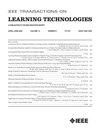Virtual Reality Body Swapping to Improve Self-Assessment in Job Interview Training
IF 2.9
3区 教育学
Q2 COMPUTER SCIENCE, INTERDISCIPLINARY APPLICATIONS
引用次数: 0
Abstract
Swapping visual perspective in virtual reality (VR) provides a unique means for embodying different virtual bodies and for self-distancing. Moreover, this technology is a powerful tool for experiential learning and for simulating realistic scenarios, with broad potential in the training of soft skills. However, there is scarce knowledge on how perspective swapping in VR might benefit the training of soft skills such as those required in a job interview. This article investigates the impact of virtual body swapping on the self-assessment of verbal and nonverbal communication skills, emotional states, and embodiment in a simulated job interview context. Three main conditions were compared: a baseline condition in which the participants practiced a job interview from the first-person perspective of a virtual interviewee (no swap condition); an external point of view condition where, first, the participants answered questions from the interviewee perspective, but then swap visual perspective to re-experience their responses from a nonembodied point of view (out of body condition); and a condition in which, after answering questions from the interviewee perspective, the participants re-experienced their responses from the embodied perspective of the virtual recruiter (recruiter condition). The experimental results indicated that the effectiveness of the out of body and recruiter conditions was superior to the no swap condition to self-assess the communication styles used during a job interview. Moreover, all the conditions led to a high level of embodiment toward the interviewee avatar when seen from the first-person perspective; in the case of the recruiter condition, the participants also felt embodied in the recruiter avatar. No differences in emotional states were found among conditions, with all sharing a positive valence.虚拟现实肢体交换技术改善求职面试培训中的自我评估
在虚拟现实(VR)中交换视觉视角为体现不同的虚拟身体和自我舞动提供了一种独特的手段。此外,这项技术还是体验式学习和模拟现实场景的有力工具,在软技能培训方面具有广泛的潜力。然而,关于虚拟现实技术中的视角互换如何有益于软技能(如求职面试中所需的技能)培训的知识还很少。本文研究了在模拟求职面试情境中,虚拟肢体交换对语言和非语言沟通技巧、情绪状态和体现的自我评估的影响。本文对三种主要条件进行了比较:在基线条件下,参与者以虚拟面试者的第一人称视角练习求职面试(无互换条件);在外部视角条件下,参与者首先以面试者的视角回答问题,然后互换视觉视角,以非实体视角重新体验他们的回答(体外条件);在以面试者的视角回答问题后,参与者以虚拟招聘者的实体视角重新体验他们的回答(招聘者条件)。实验结果表明,在对求职面试中使用的沟通方式进行自我评估时,"出体 "条件和 "招聘者 "条件的效果优于 "无交换 "条件。此外,从第一人称视角来看,所有条件都会使受试者对面试者的化身产生高度的代入感;在招聘者条件下,受试者也会对招聘者的化身产生代入感。在不同的条件下,参与者的情绪状态没有差异,所有条件下的情绪都是积极的。
本文章由计算机程序翻译,如有差异,请以英文原文为准。
求助全文
约1分钟内获得全文
求助全文
来源期刊

IEEE Transactions on Learning Technologies
COMPUTER SCIENCE, INTERDISCIPLINARY APPLICATIONS-
CiteScore
7.50
自引率
5.40%
发文量
82
审稿时长
>12 weeks
期刊介绍:
The IEEE Transactions on Learning Technologies covers all advances in learning technologies and their applications, including but not limited to the following topics: innovative online learning systems; intelligent tutors; educational games; simulation systems for education and training; collaborative learning tools; learning with mobile devices; wearable devices and interfaces for learning; personalized and adaptive learning systems; tools for formative and summative assessment; tools for learning analytics and educational data mining; ontologies for learning systems; standards and web services that support learning; authoring tools for learning materials; computer support for peer tutoring; learning via computer-mediated inquiry, field, and lab work; social learning techniques; social networks and infrastructures for learning and knowledge sharing; and creation and management of learning objects.
 求助内容:
求助内容: 应助结果提醒方式:
应助结果提醒方式:


